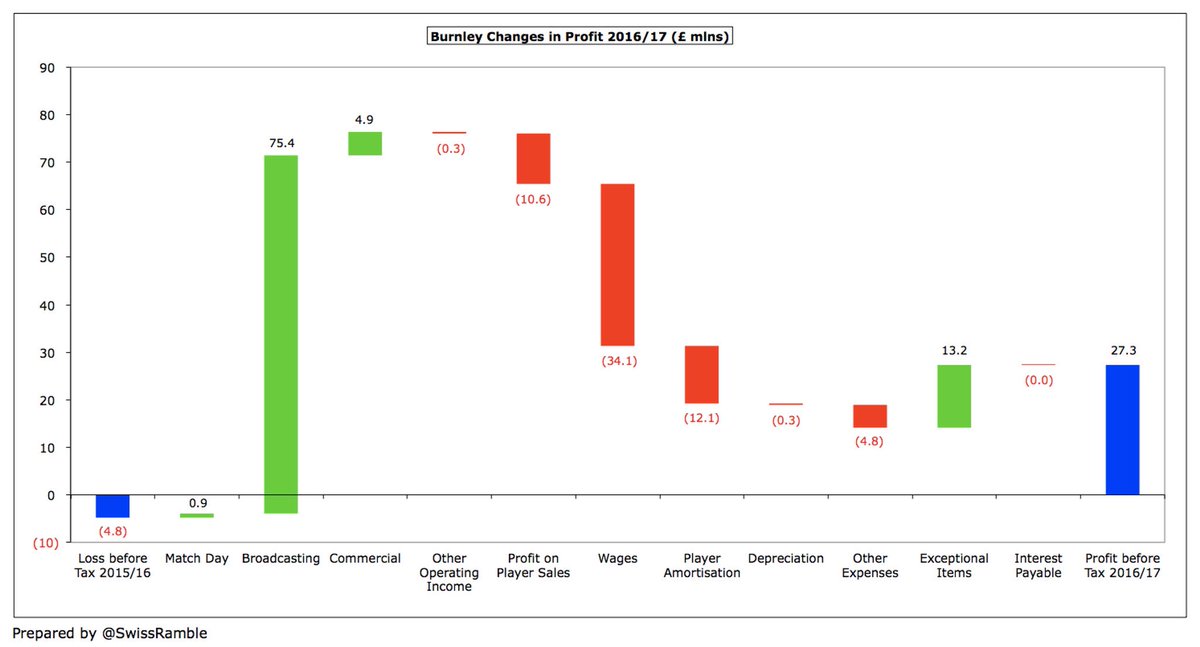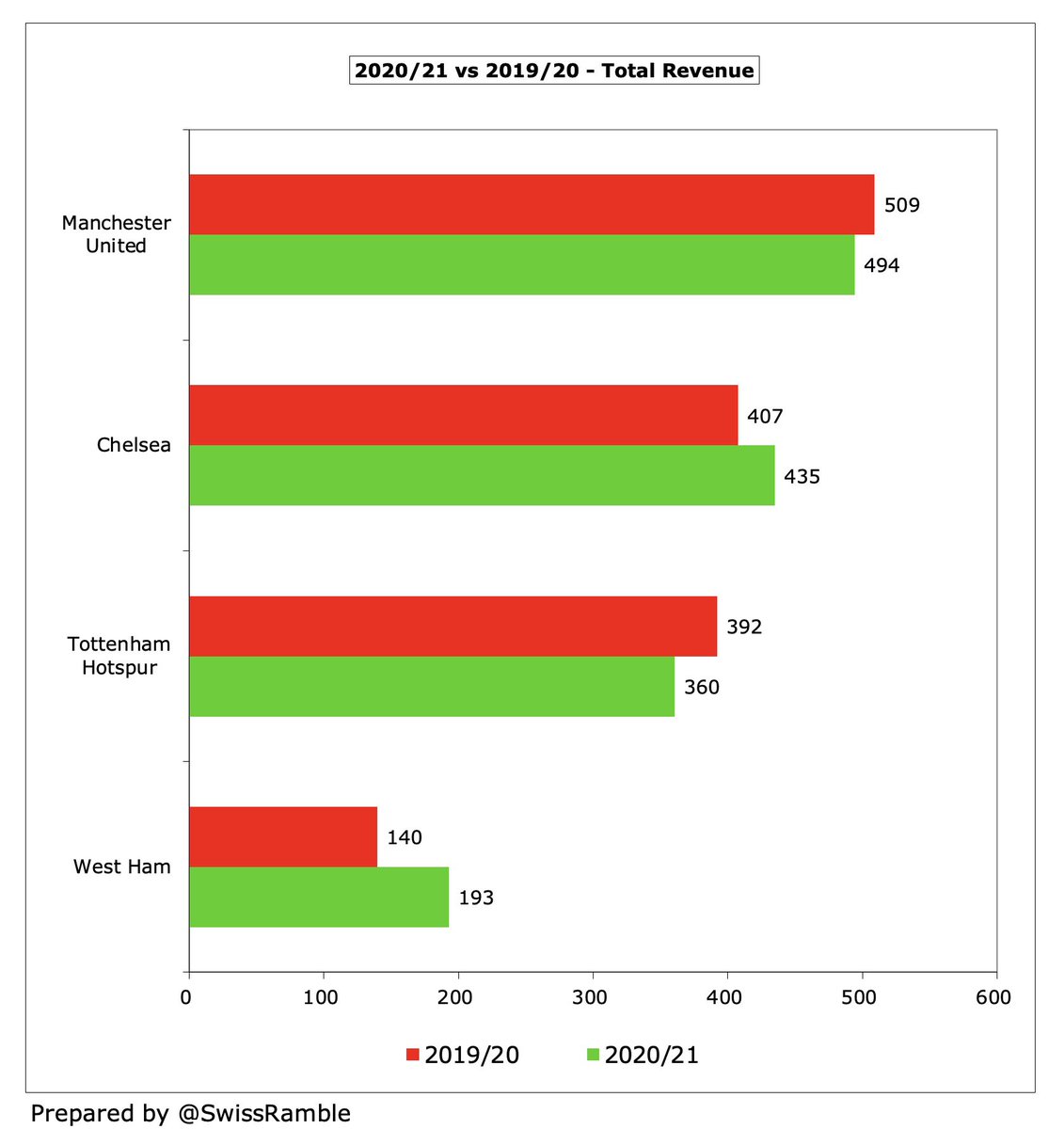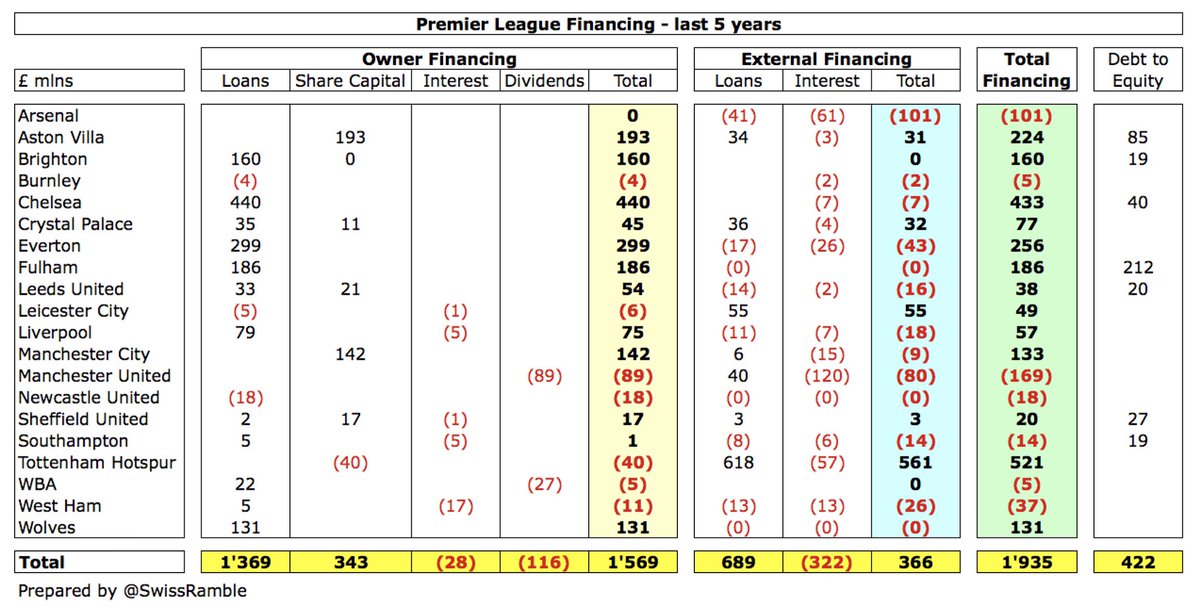Discover and read the best of Twitter Threads about #BurnleyFC
Most recents (17)
🏆 PREMIOS EFL 2022/23
Como viene siendo habitual y con la temporada en las tres categorías ya cerradas, es momento de premiar a los mejores jugadores y entrenadores.
Este año vuelvo a incluir #NationalLeague tras seguirla más que en otras ediciones.
Here we go!
Como viene siendo habitual y con la temporada en las tres categorías ya cerradas, es momento de premiar a los mejores jugadores y entrenadores.
Este año vuelvo a incluir #NationalLeague tras seguirla más que en otras ediciones.
Here we go!

👔 MEJOR ENTRENADOR CHAMPIONSHIP
🟣 Vincent Kompany
Puede resultar sencillo, pero el belga ha liderado una transformación profunda en #BurnleyFC con sello propio que ha permitido dominar con mano de hierro la competición. Equipo de autor: alegre, ofensivo y fiel a su idea.
🟣 Vincent Kompany
Puede resultar sencillo, pero el belga ha liderado una transformación profunda en #BurnleyFC con sello propio que ha permitido dominar con mano de hierro la competición. Equipo de autor: alegre, ofensivo y fiel a su idea.
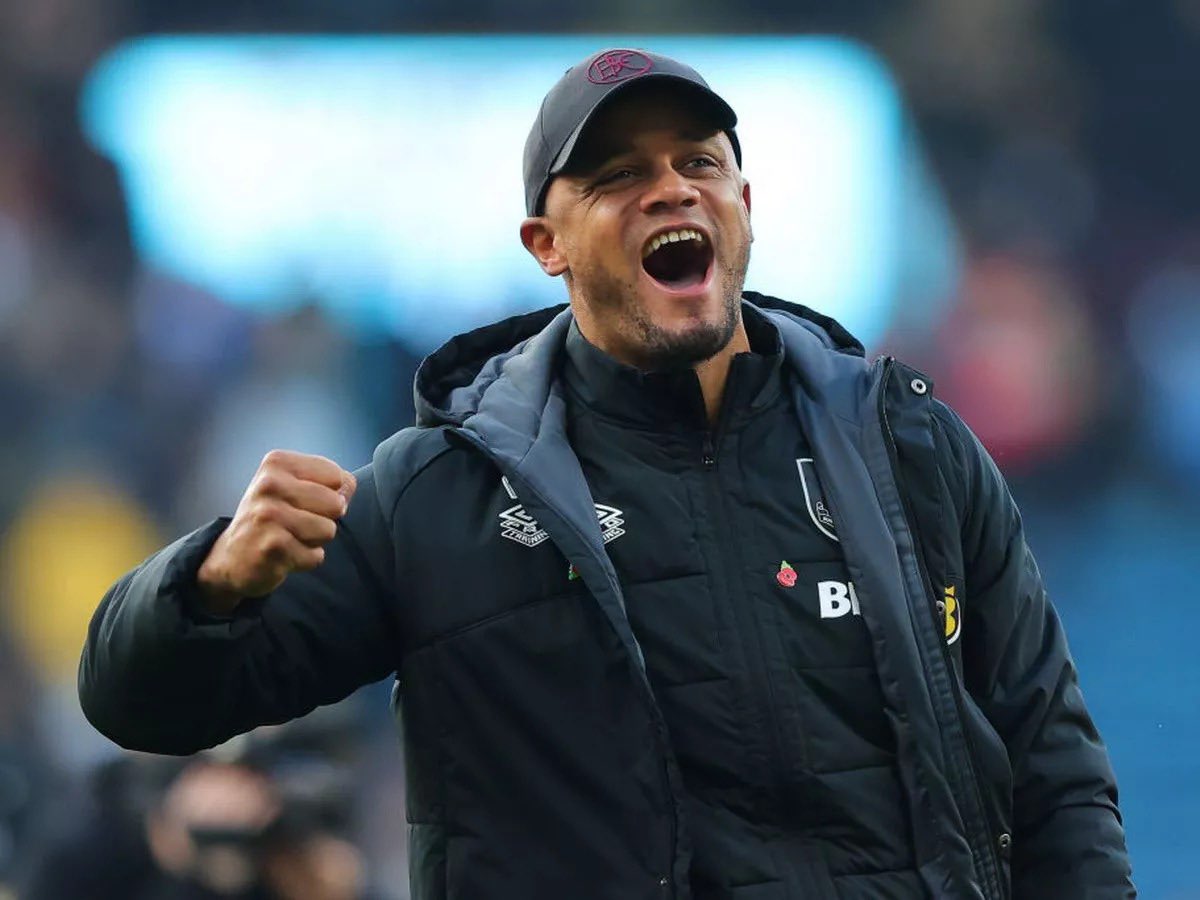
⚽️ MEJOR JUGADOR CHAMPIONSHIP
🇸🇳 Iliman N’Diaye
Jugón, con todas las letras. Ha sido la temporada definitiva de su irrupción y consolidación. Clave para entender el ascenso de #SheffieldUnited desde el enganche o incluso falso 9. Es una barbaridad en espacios reducidos.
🇸🇳 Iliman N’Diaye
Jugón, con todas las letras. Ha sido la temporada definitiva de su irrupción y consolidación. Clave para entender el ascenso de #SheffieldUnited desde el enganche o incluso falso 9. Es una barbaridad en espacios reducidos.

If you haven’t yet had the chance, I would highly recommend taking in a Burnley match before the end of the season.
Vincent Kompany has successfully transitioned the club to a possession based style, with Burnley 5 points clear of 2nd placed Sheffield United after 28 games.
Vincent Kompany has successfully transitioned the club to a possession based style, with Burnley 5 points clear of 2nd placed Sheffield United after 28 games.

In advance of football clubs starting to publish their accounts for the 2021/22 season, I thought it might be helpful to share some 2-page financial overviews for each of the Premier League clubs for 2020/21, including a comparison against prior year and a 5-year graphical trend.
These overviews also include Premier League rankings for each of the main financial categories, e.g. which club had the highest profit, loss, revenue, wages, debt, transfer spend, etc in 2020/21.
One caveat with these figures is that revenue was significantly impacted by COVID in 2020/21 with match day reduced to almost zero, as games were played behind closed doors, while some broadcasting income was deferred from 2019/20 for matches played after the accounting close.
Leeds United and Burnley have written to the Premier League, threatening to take legal action for their failure to punish Everton for what they believe to be a serious breach of the regulations. Relegation would have significant financial consequences. #EFC #LUFC #BurnleyFC
If a club breaches the Premier League’s Profitability and Sustainability rules, it can face sanctions ranging from fines to points deductions. #LUFC and #BurnlyyFC would argue that #EFC have enjoyed a competitive advantage, as the league has not sanctioned their high spending.
#EFC are adamant that they are in line: “'We have worked so closely with the Premier League to make sure we are compliant. We are comfortable we have complied with the rules. External auditors have told us what we can and cannot claim against the pandemic.”
Four Premier League clubs have now published their accounts for the 2020/21 season and it may surprise to many fans that two of them managed to increase their revenue in a season so badly impacted by the pandemic. This thread will explain the reasons, which are mainly technical.
The COVID-19 pandemic has had a significant adverse impact on football clubs, though it is important to distinguish between money that has been completely lost to the game and income that has simply been deferred. This thread will analyse what this means for the Premier League.
Many clubs have listed the revenue impact of COVID-19 in their accounts, while others have not quantified the amounts. In the latter case, I have made assumptions consistent with those clubs who have provided figures in order to estimate the impact.
Burnley’s 2019/20 financial results covered a season when they finished in 10th place, the club’s second highest Premier League finish, securing a fifth consecutive season in the top flight. Some thoughts follow #BurnleyFC #twitterclarets
After these accounts closed in December 2020 ALK capital acquired a majority (84%) shareholding in #BurnleyFC. Long-term local owners Mike Garlick and John Banaszkiewicz remain at Turf Moor as directors, working in partnership with new chairman Alan Pace.
#BurnleyFC profit before tax dropped from £5m to break-even, mainly due to COVID impact, including an additional month of expenses. Revenue fell £4m (3%) from £138m to £134m and expenses increased £9m, though profit on player sales rose £8m to £15m. Profit after tax was £0.5m. 
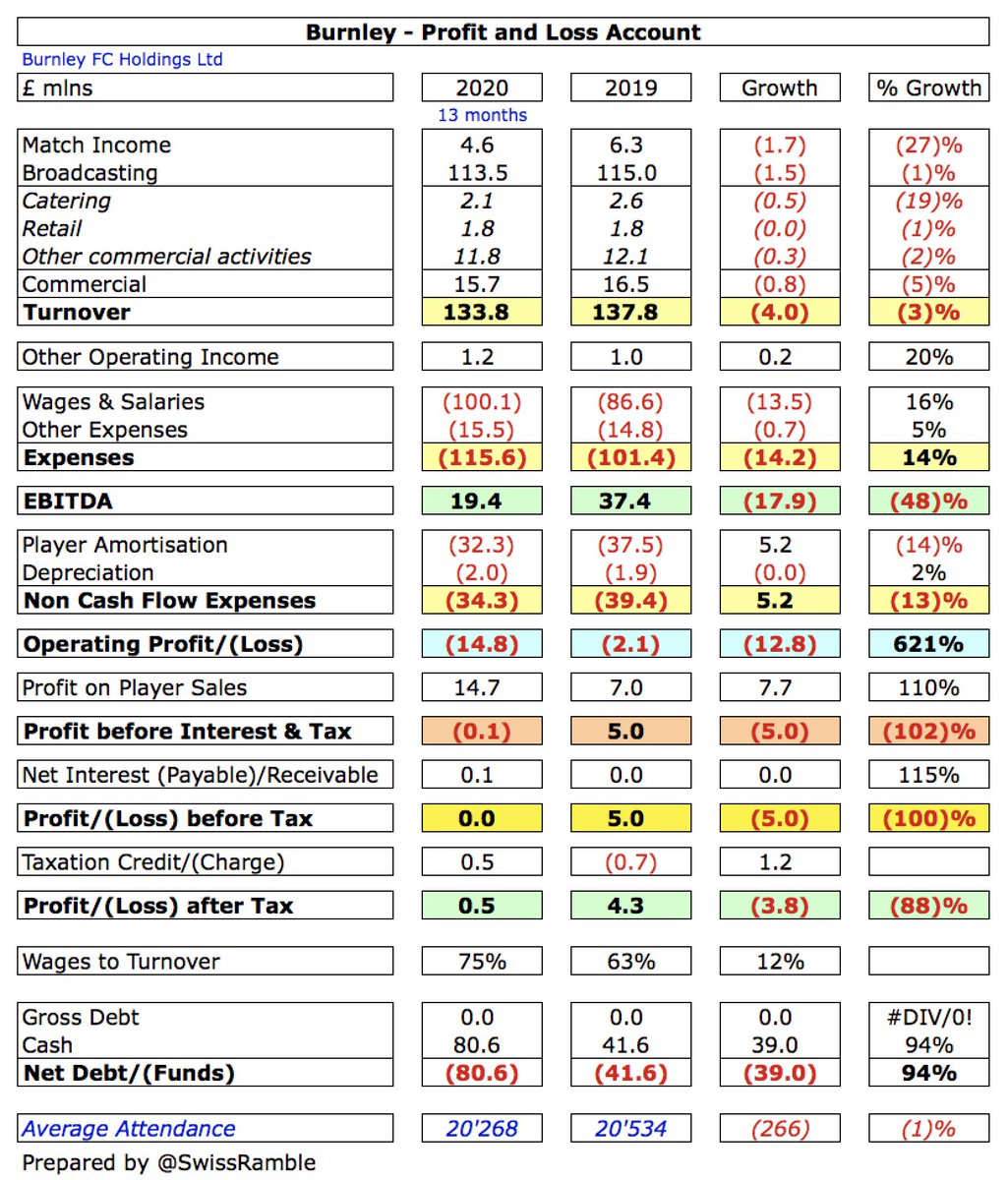
Football clubs generate most of their cash from revenue they earn from gate receipts, TV deals, prize money, sponsorship and merchandising, but often they need additional financing, either from their owners or the banks. This thread looks at financing in the Premier League.
This analysis will cover the last five years from 2014/15 to 2018/19 (the last season when accounts are available), looking at the 20 clubs currently in the Premier League, i.e. including those promoted last season.
As the 2019/20 Premier League season finally comes to a close, I thought that it might be interesting to look at the impact of climbing or dropping places in the league table. There might be more for teams to play for than people might think.
As a reminder, in 2018/19 each club received equal shares for 50% of domestic TV £34m, overseas TV £43m and commercial income £5m. Each match broadcast live was worth £1.1m (on top of £12.2m for a minimum of 10 games), while each league position was worth £1.9m (merit payment). 
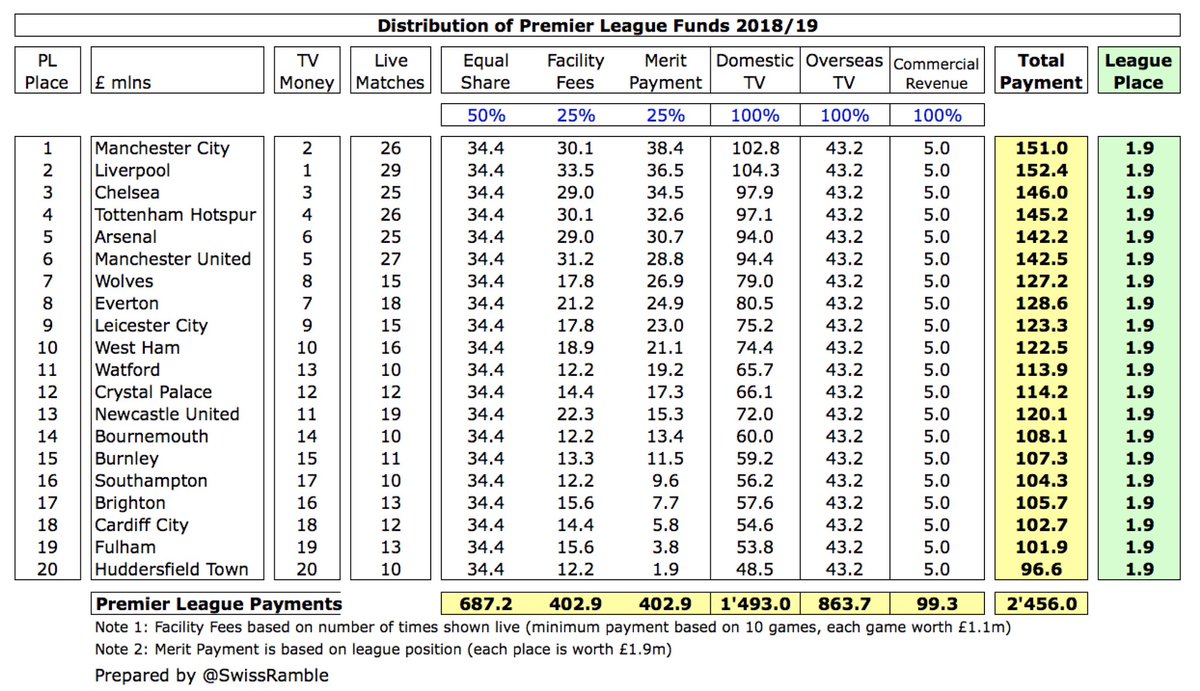
However, the story has changed with the new 3-year deal for the 2019-22 cycle, as the numbers are different and there is a twist in the distribution methodology used for the overseas TV rights. This is important, as overseas is the area driving the growth in TV money.
Earlier this week I posted a thread on the 2018/19 financials for the Big Six Premier League clubs. Today I am going to look at the numbers for the Other 14 clubs #AFCB #BHAFC #BurnleyFC #CardiffCity #CPFC #EFC #FFC #HTAFC #LCFC #NUFC #SaintsFC #WatfordFC #WHUFC #WWFC
Now that all the Premier League clubs have published their 2018/19 financials, we can compare the results, but we will do this a little differently by separating the analysis into two parts, as the numbers are so different for: (1) the Big Six clubs; and (2) the Other 14 clubs.
Burnley’s 2018/19 financial results covered a season when they finished 15th in the Premier League, securing a fourth consecutive season in the top flight, and competed in Europe for the first time in over 50 years. Some thoughts follow #BurnleyFC
#BurnleyFC profit before tax dropped from a club record £45m to £5m, mainly because profit on player sales fell £24m from £31m to £7m, though revenue was also slightly lower at £138m and expenses increased £15m. Profit after tax was down from £37m to £4m. 
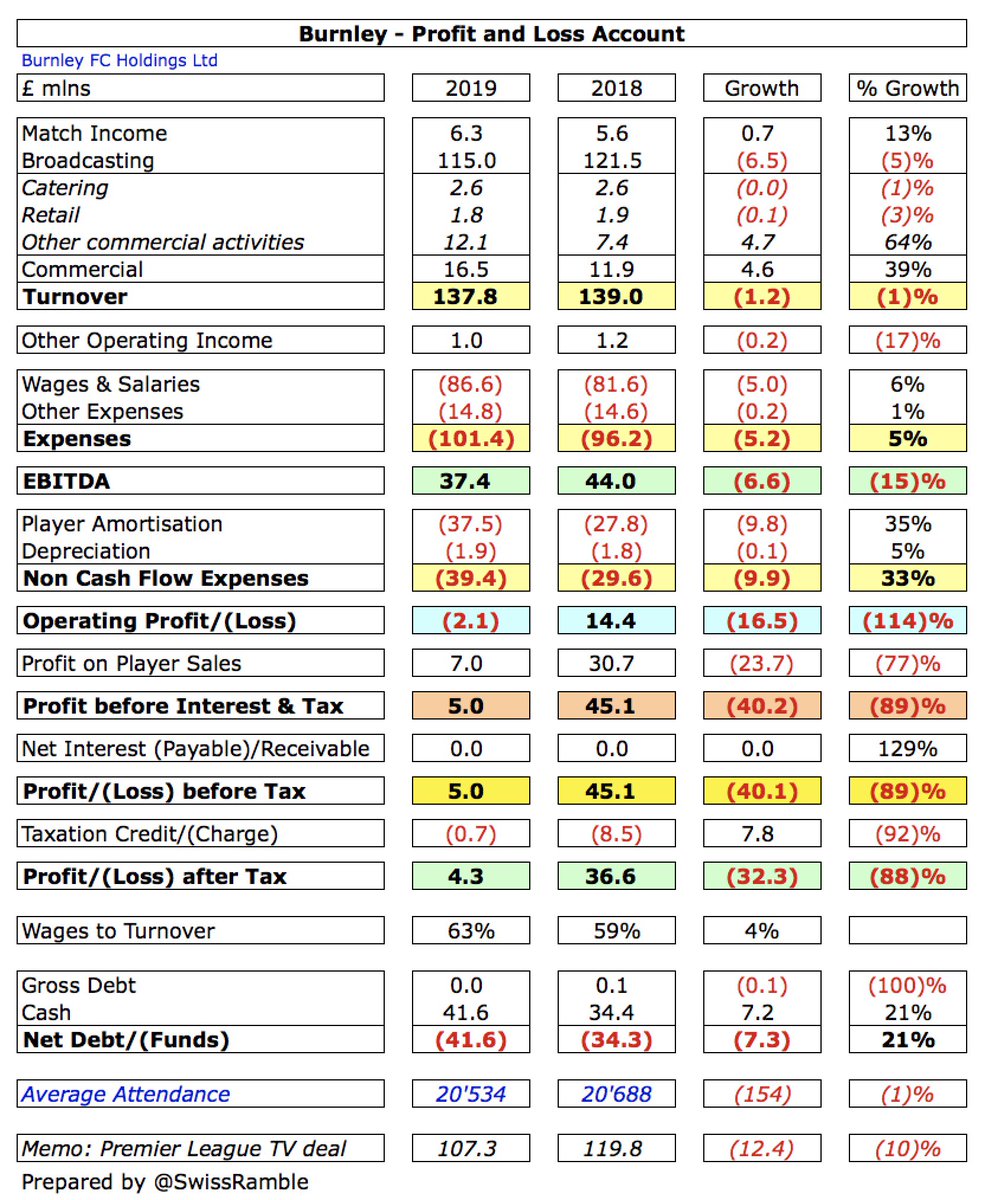
#BurnleyFC £1m (1%) revenue fall was very largely driven by broadcasting’s £7m (5%) decrease from £122m to £115m, due to lower prize money for finishing 15th (against 7th prior year). In contrast, commercial rose £4.6m (39%) to £16.5m and match day was up £0.7m (13%) to £6.3m. 
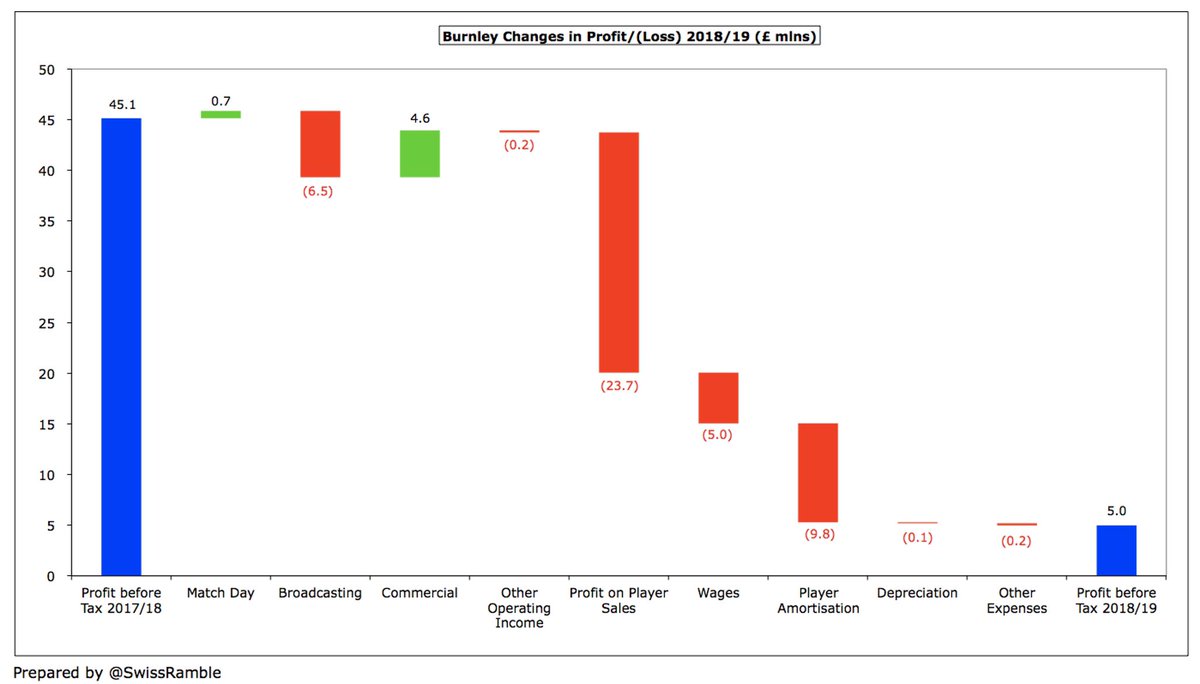
A previous thread explained the differences between a football club’s profit and loss account and its cash flow statement, as it is important to understand where the money has been spent. This thread will look at how this works for each of the 20 Premier League clubs in 2017/18.
#AFC went from £52m operating profit to £42m operating loss, due to lower revenue after failing to qualify for the Champions League, compounded by higher wages and player amortisation plus Wenger pay-off. However, £120m profit on player sales resulted in £70m profit before tax. 
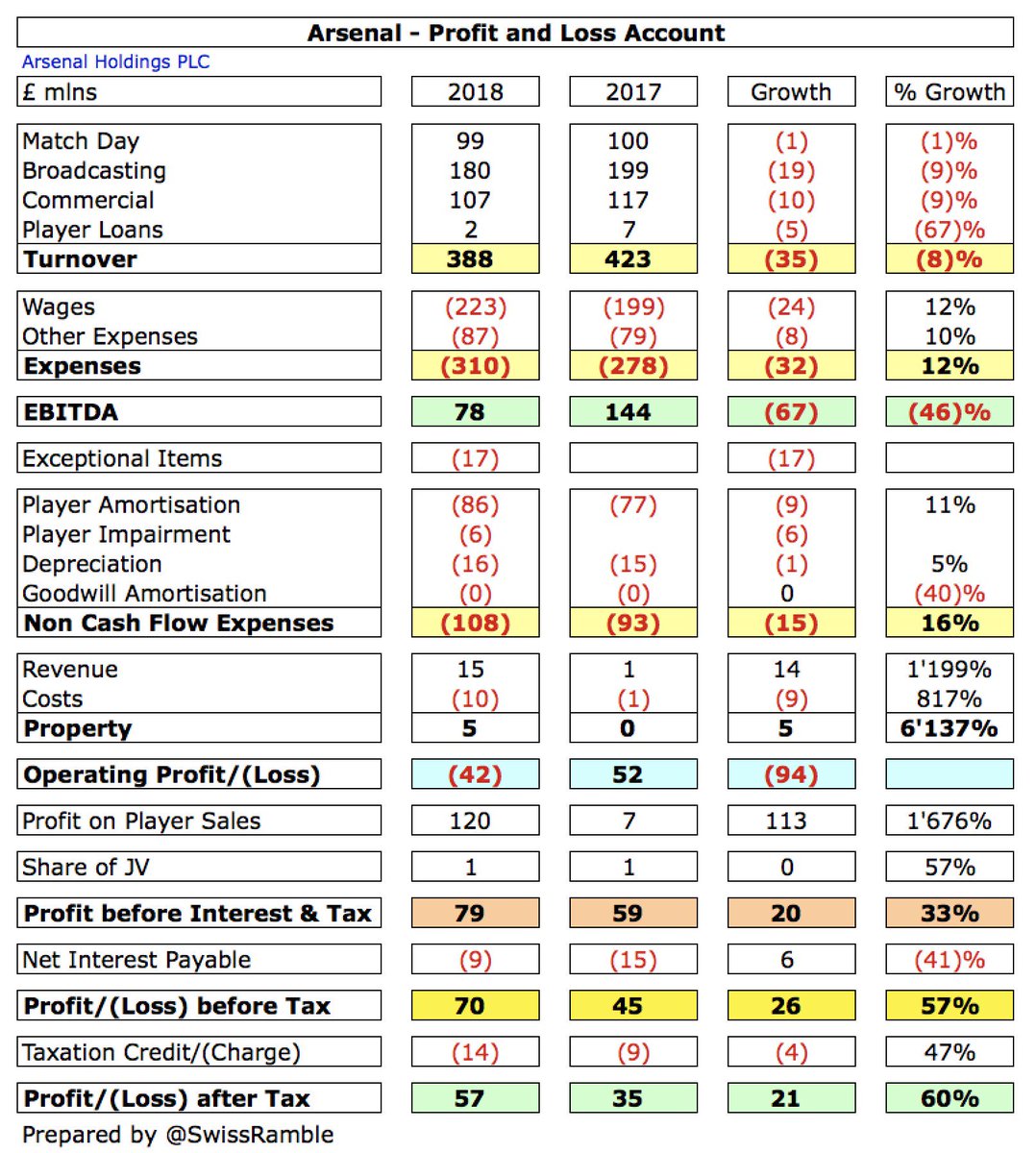
#AFC cash flow boosted by favourable £58m movement in working capital (increase in creditors). Spent £29m (net) on players (purchases £110m, sales £81m). Paid £20m for Emirates loan (£11m interest & £9m debt) plus £12m tax. Net cash inflow of £51m was highest in Premier League. 
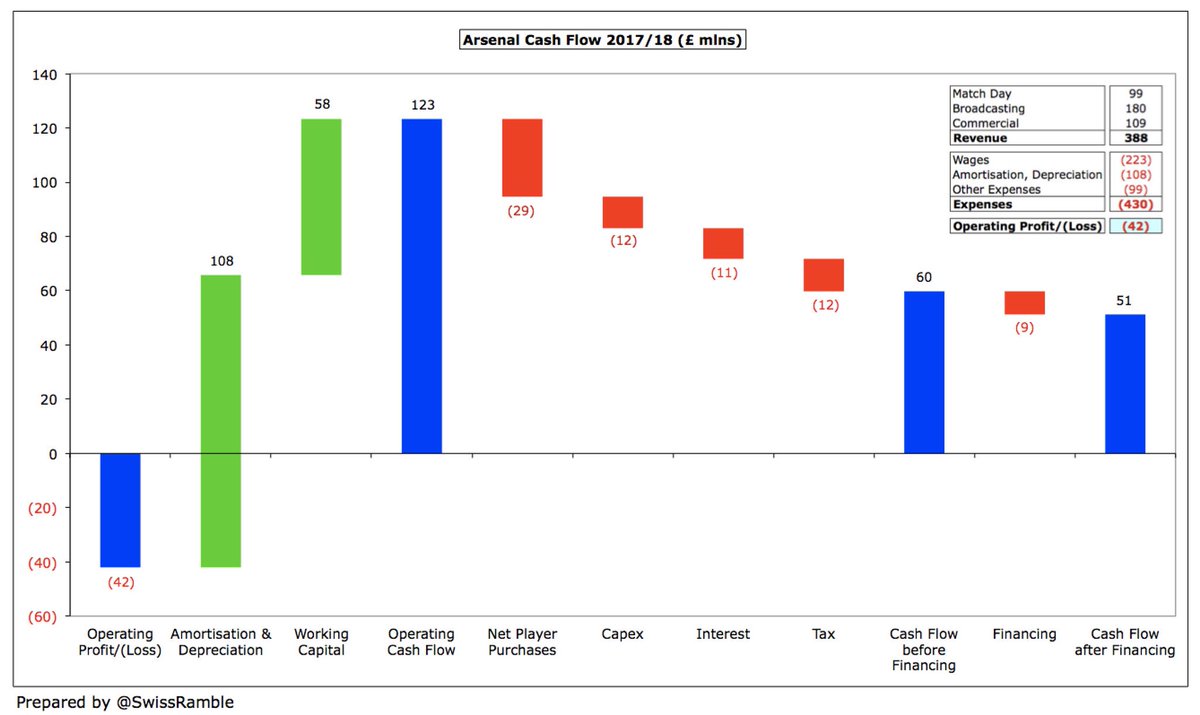
The Premier League has published its TV revenue for the 2018/19 season, ranging from £97m for #HTAFC to £152m for #LFC, who earned more than league winners #MCFC £151m, due to more matches broadcast live. Some thoughts in the following thread. 

Each club receives equal shares for 50% of domestic TV £34.4m, overseas TV £43.2m and commercial income £5.0m. Each league position is worth £1.9m (merit payment), while each match broadcast live is worth £1.1m (on top of £12.2m for a minimum of 10 games).
Following my recent analyses of where Premier League and Championship clubs source their money and what they spend it on, I received many questions on how a cash flow statement works, so I will explain the mechanics (using Premier League season 2016/17) in the following thread.
Traditionally, supporters have focused on a club’s profit and loss account, which is not surprising, because: (a) that is what the media tend to report; (b) it is intuitively easy to understand, being basically revenue less expenses (mainly player wages).
Nevertheless, the reported figure is an accounting profit, which is not necessarily a “real” cash profit, as it is based on the accountant’s accruals concept and this can be very different from actual cash movements.
THREAD: 🏴 #PremierLeague strength of schedule breakdown 📊
We rank each side on how many points they can expect to pick up from the next six games using our xG model 👇
We rank each side on how many points they can expect to pick up from the next six games using our xG model 👇
1. #ManCity – 14.3 xPoints
City will face sides with an average position of just above midtable over the next six games, looking at average of 2.38 xPoints per game.
#MCFC @City_Watch @City_Chief @SuperbiaProeIia @PicturedCity @City_Xtra @9320pod 👇
City will face sides with an average position of just above midtable over the next six games, looking at average of 2.38 xPoints per game.
#MCFC @City_Watch @City_Chief @SuperbiaProeIia @PicturedCity @City_Xtra @9320pod 👇
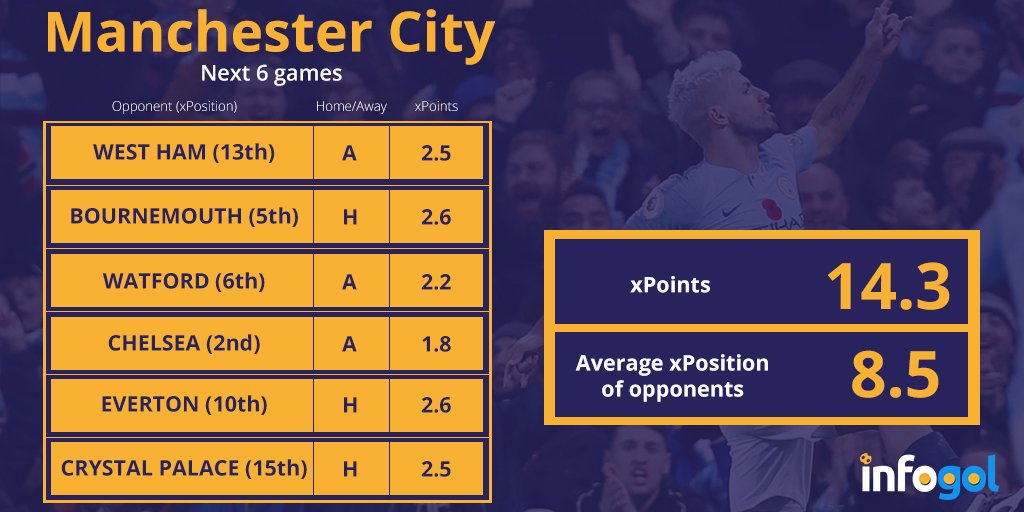
2. #LFC – 13.2 xPoints
Liverpool look set to continue their good start to the season. Despite facing #MUFC, we make the Reds’ trip to #WatfordFC their hardest fixture.
@AnfieldEdition @AnfieldHQ @TheRedmenTV @LFCData @anfieldonline @BassTunedToRed 👇
Liverpool look set to continue their good start to the season. Despite facing #MUFC, we make the Reds’ trip to #WatfordFC their hardest fixture.
@AnfieldEdition @AnfieldHQ @TheRedmenTV @LFCData @anfieldonline @BassTunedToRed 👇
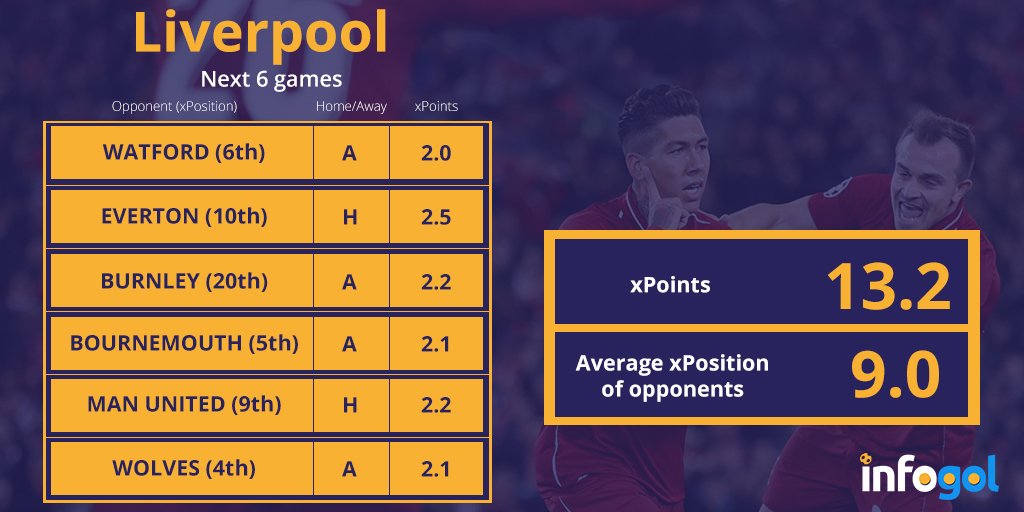
Burnley’s 2016/17 financial results covered a season when they finished 16th in the Premier League, thus securing consecutive seasons in the top flight for the first time since 1974, having been promoted from the Championship in 2015/16. Some thoughts follow #BurnleyFC
Following promotion to the Premier League #BurnleyFC converted a pre-tax £4.8m loss to £27.3m profit, as revenue tripled from £40m to a record £121m, though profit on player sales was down £11m to £1.3m. After tax, the club made a £22.2m profit, compared to a £3.7m loss in 15/16. 

#BurnleyFC £81m revenue growth was very largely driven by broadcasting’s £75m increase to £105m, due to the much higher money in the Premier League (plus first year of new deal), while commercial also increased £4.9m (91%) to £10.4m and match day was £0.9m (18%) up at £5.8m. 
